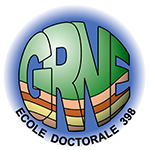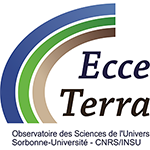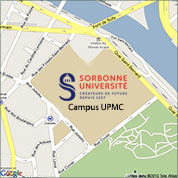Magmas at Depth

An experimental study at extreme conditions
Starting grant ERC 2010-259649
Responsable : C. Sanloup (Istep)
This programme, anchored on the in situ study of silicate liquids at high pressure, aims at answering questions relevant to the presence of magmas at depth, whether that be in the present Earth or in its earliest times, during differentiation of the planet.
Melts have unique physical and chemical properties, which vary as a function of temperature (T), pressure (P), and chemical composition. Nearly every stage in the genesis of magma depends on the density contrast between silicate liquids and crystals, from the control of the chemical composition to the ascent rate of magmas. The first objective here is therefore to measure the density of magmas in situ as a function of P, derive their equation of state, and assess their stability vs instability at depth by comparison with the equation of state of surrounding mantle or crustal crystalline materials.
Understanding the macroscopical physical properties of magmas requires an accurate microscopic structural description. Despite the lack of periodicity and long-range order, melts retain a characteristic short-range order, which obeys basic crystal-chemical rules. However, only a limited amount of information exists about changes in silicate melts structure with T or P or both, and that information is only indirect as it comes from the study of glasses. The difficulty comes from the prediction of the changes in melts at high P and T (as opposed to recovered glasses) and from the partial reversibility of the P-induced coordination changes. Any such structural transition must be tracked in the liquid state as it could profoundly affect not only the physical properties of the melt but also its chemical properties, i.e. the way elements partition between the melt and crystals upon partial melting of the source mantle or later upon fractional crystallisation of the magma. The second objective is therefore to establish the structure of one-component and simplified multi-component melts relevant for mantle and crustal magmas at high P. This will thus determine the structural environment (interatomic distances, coordination numbers) of the main elements in silicate melts as a function of P-T conditions.
To conduct this program, I have chosen a multi-disciplinary laboratory, the Centre for Science at Extreme Conditions of the University of Edinburgh. Earth and planetary sciences belong traditionally to observational sciences, generating numerous precise data and raising by empirical observation interesting physical and chemical relationships. The study of magmas at depth in planets, natural high P-T laboratories, will doubtless provide new examples of this.
Chiffres clés (Mars 2025)
L'ISTeP comprend 131 membres dont :
Permanents (66)
- Professeurs : 17 (+2 PAST)
- Maîtres de conférence : 26
- Directeurs de recherche CNRS : 1
- Chargés de recherche CNRS : 1
- ITA : 19
Personnels non permanents (65)
- Collaborateurs bénévoles / émérites : 17
- Chaire de professeur junior : 1
- Enseignants-chercheurs contractuel : 2
- 1 MCF accueil en délégation
- ATER et Post-Docs : 9
- Doctorants : 32
- ITA-BIATSS : 3





